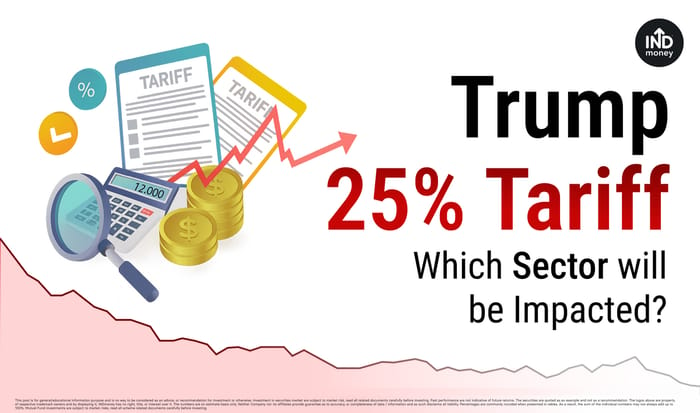
- Why Did the U.S. Impose These Tariffs?
- Trade Snapshot: Sector-Wise Impact:
- Real-World Consequences
- What Can India Do Now? Likely Government Strategies
- Conclusion: A Strategic Game With Economic Risks
On July 30, 2025, U.S. President Donald Trump announced a 25% import tariff on all Indian goods starting August 1. The move is not limited to a few items; it is a blanket tariff on nearly $87 billion worth of Indian exports to the U.S. (2024 figures). This has triggered immediate concerns across India’s export-heavy sectors.
Let’s break this down through an analytical lens:
Why Did the U.S. Impose These Tariffs?
1. High Indian Tariffs on U.S. Products
- India’s average tariff on agricultural imports is nearly 39%
- Trump has long claimed that the U.S. is not getting a fair deal, calling India the “tariff king.”
- He aims to use these tariffs to pressure India into opening its markets
2. India’s Trade With Russia
- India continues to buy Russian oil and military hardware despite Western sanctions
- In 2024, Russia accounted for over 30% of India’s crude oil imports
- The new U.S. tariff has been positioned as a penalty for not aligning fully with Western sanctions on Russia
Trade Snapshot: Sector-Wise Impact:
India’s Exports to the United States were around $87 billion during 2024. The U.S. is India’s largest export market. Roughly 17.90% of India’s total goods exports go to the U.S., so even a 5–10% drop could translate to billions in lost revenue. Here’s how key Indian export sectors stack up in terms of exposure and potential tariff impact:
1. Textiles & Apparel
- Exports to U.S.: ~$5.1 billion
- U.S. share: Nearly 25% of India’s textile and apparel exports
- U.S. retailers may shift sourcing to Bangladesh or Vietnam
- India’s textile industry employs over 45 million people; any export dip could lead to job losses
2. Gems & Jewelry
- Exports to U.S.: ~$9.1 billion
- Key items: Cut diamonds, gold jewelry, silver articles
- U.S. share: Around 28–30% of India’s total jewelry exports
- Higher prices may lead to reduced or delayed orders from U.S. buyers
- The sector is already facing stress due to the global slowdown and gold price volatility
3. Engineering Goods (Machinery, Auto Parts
- Exports to U.S.: ~$6.5 billion
- U.S. buyers may shift to Mexico, China, or domestic sources
- Could impact the momentum of Make-in-India and PLI-driven engineering exports
- Small and mid-sized exporters could face significant order losses
4. Electronics & Electrical Equipment
- Exports to U.S.: ~$12.3 billion
- Key items: Mobile phones, telecom gear, circuit boards
- Tariffs will reduce India’s cost advantage in electronics
- It could weaken India’s growing electronics export momentum
- Logistic and quality control issues may worsen price competitiveness
5. Agricultural Products
- Exports to U.S.: ~$820 million (including rice, spices, tea, coffee)
- Indian-origin food products will become costlier in ethnic U.S. markets
- U.S. buyers may reduce imports or switch to alternate suppliers
- Smaller farmers and exporters could be affected
6. Steel, Chemicals & Petroleum Products
- Exports to U.S. (combined): ~$8.1 billion
- India may lose ground to competitors like Vietnam and Brazil
- Reduced export demand may hit large producers and MSMEs alike
7. Pharmaceuticals (May be exempted)
- Exports to U.S.: ~$8.7 billion
- Earlier, Trump had exempted pharma from tariffs; however, no clarity has been provided on the updated exemption list
Real-World Consequences
- Export Slowdown:: If even 25% of Indian exports to the U.S. decline, that is a potential loss of $21.75 billion in trade revenue annually
- Jobs at Risk: Sectors like textiles, jewelry, and auto parts are labour-intensive, together employing over 70 million people
- Currency & Stock Pressure: INR could see short-term pressure as export earnings dip. Export-focused stocks ( textiles, metal, jewelry) may underperform until a resolution is in sight
What Can India Do Now? Likely Government Strategies
- Resume Talks: India is aiming for a mid-August restart to trade negotiations A deal by October 2025 could roll back tariffs
- Concessions Package: Lower import duties on key U.S. products (like dairy or tech equipment). Agree to buy more American LNG, defence goods, etc.
- Export Diversification: Indian exporters may explore Europe, Africa, and Southeast Asia as fallback markets
- Support Schemes: Incentives or subsidies expected (like extended RoDTEP or interest support) for affected exporters
Conclusion: A Strategic Game With Economic Risks
This 25% tariff is not just about trade; it is a geopolitical pressure tool. But for India, the economic fallout is very real. The extent of damage depends on:
- How long the tariffs stay
- Whether India can negotiate a rollback
- How quickly businesses can adapt or pivot
Until then, both governments are in a high-stakes standoff, and Indian exporters are bracing for impact.